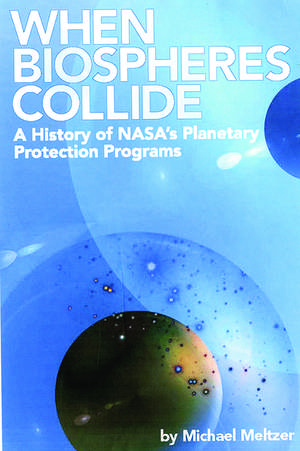4234 When Biospheres Collide: A History of NASA's Planetary Protection Programs: A History of NASA's Planetary Protection Programs: NASA SP
Autor Michael Meltzeren Limba Engleză Hardback – 31 aug 2011 – vârsta de la 18 până la 95 ani
NOTE: NO FURTHER DISCOUNT FOR THIS PRINT PRODUCT- OVERSTOCK SALE -- Significantly reduced list price
This new book from the NASA History Series tackles an interesting duo of biological problems that will be familiar to anybody who has seen photos of Apollo astronauts quarantined after their return to Earth. Namely, how do we avoid contaminating celestial bodies with Earthly germs when we send spacecraft to study these bodies, and how do we avoid spreading foreign biological matter from space when our robotic and human spacefarers return to Earth? Biological matter from an external system could potentially cause an unchecked epidemic either on Earth or in space so strict precautions are necessary.
This new book from the NASA History Series tackles an interesting duo of biological problems that will be familiar to anybody who has seen photos of Apollo astronauts quarantined after their return to Earth. Namely, how do we avoid contaminating celestial bodies with Earthly germs when we send spacecraft to study these bodies, and how do we avoid spreading foreign biological matter from space when our robotic and human spacefarers return to Earth? Biological matter from an external system could potentially cause an unchecked epidemic either on Earth or in space so strict precautions are necessary.
Each time a space vehicle visits another world it runs the risk of forever changing that extraterrestrial environment. We are surrounded on Earth by a mélange of different microorganisms, and if some of these hitchhike onboard a space mission, they could contaminate and start colonies on a different planet. Such an occurrence would irrevocably alter the nature of that world, compromise all future scientific exploration of the body, and possibly damage any extant life on it. By inadvertently carrying exotic organisms back to Earth on our spacecraft, we also risk the release of biohazardous materials into our own ecosystem. Such concerns were recognized by scientists even before the 1957 launch of Sputnik.
This book presents the history of planetary protection by tracing the responses to the above concerns on NASA’s missions to the Moon, Mars, Venus, Jupiter, Saturn, and many smaller bodies of our solar system. The book relates the extensive efforts put forth by NASA to plan operations and prepare space vehicles that return exemplary science without contaminating the biospheres of other worlds or our own. To protect irreplaceable environments, NASA has committed to conducting space exploration in a manner that is protective of the bodies visited, as well as of our own planet.
Other products produced by NASA can be found here: https://bookstore.gpo.gov/agency/550
Preț: 224.45 lei
Nou
Puncte Express: 337
Preț estimativ în valută:
42.95€ • 44.96$ • 35.54£
42.95€ • 44.96$ • 35.54£
Carte indisponibilă temporar
Doresc să fiu notificat când acest titlu va fi disponibil:
Se trimite...
Preluare comenzi: 021 569.72.76
Specificații
ISBN-13: 9780160853272
ISBN-10: 0160853273
Pagini: 542
Ilustrații: Illustrated
Dimensiuni: 165 x 254 x 38 mm
Ediția:First
Editura: US National Aeronautics and Space Admin
Colecția U.S. National Aeronautics and Space Administration
Seria NASA SP
ISBN-10: 0160853273
Pagini: 542
Ilustrații: Illustrated
Dimensiuni: 165 x 254 x 38 mm
Ediția:First
Editura: US National Aeronautics and Space Admin
Colecția U.S. National Aeronautics and Space Administration
Seria NASA SP
Notă biografică
Michael Meltzer has been writing books and articles about science and technology for over 30 years. He has investigated topics that include NASA expeditions to Jupiter and Saturn, planetary environmental protection, solar house design, industrial pollution prevention, and the history of U.S. commercial fishing. He has also published two science fiction stories with environmental themes. Michael has degrees in physics, geophysics, and environmental science and engineering from the University of California. He was an engineer at Lawrence Livermore National Laboratory for 15 years, where he helped start a pollution prevention program. He lives in Oakland, California.
Cuprins
Table of Contents
List of Figures
List of Tables
Preface
Foreword
Acknowledgments
Chapter 1: Why We Must Protect Planetary Environments
Chapter 2: In the Beginning: The Need for Planetary Protection Is Recognized
Chapter 3: Developing Effective Planetary Protection Approaches
Chapter 4: Back Contamination: The Apollo Approach
Chapter 5: Planetary Protection for Mars: The Viking Experience
Chapter 6: Small Bodies of the Solar System
Chapter 7: Return to Mars
Chapter 8: Do We Have the Right to Contaminate? The Ethical and Legal Aspects of Planetary Protection
Chapter 9: Conclusion
Appendices:
A. Detailed Planetary Protection Requirements
B. The Impact of “Faster, Better, Cheaper” on Planetary Protection Priorities
C. Biohazard Identification: The Synergism Between Bioterror Prevention and Planetary Protection Research
D. Committees, Organizations, and Facilities Important to the Development of Planetary Protection
E. Timeline of Important Planetary Protection-Related Events
F. Planetary Protection Approaches Used on Various Missions
Acronyms and Abbreviations
NASA History Series
Index
